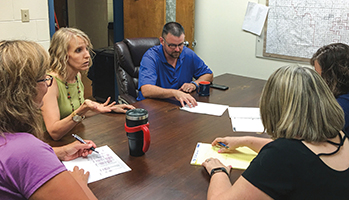A Logistical Challenge: Being Present in Two Communities
October 01, 2018

My calendar is bursting. Today, I have a roof project scheduled to begin at the K-12 building in Callaway, and I must meet with the construction company before they begin. Meanwhile, in Arnold my auditors are scheduled to begin reviewing our finances.
I am needed in both places, 21 miles and 25 minutes apart.
I begin at the school in Arnold (population 578) in central Nebraska, one of my office workplaces. With the requisite cup of coffee in hand, I sign some paperwork and review a federal
Department of Education student data report before making the drive to Callaway (population 529).
I meet with the roof project foreman, discuss existing rock and rubber removal and doublecheck the timeline for project completion. Then I
finalize my response for the report I started reviewing earlier in Arnold. By noon, I’m ready to head back to meet with the auditors and complete their questionnaire.
Disparate Personalities
My initiation to the superintendency is that of being shared between Arnold and Callaway, two rural communities separated by the beautiful South Loup River Valley. Formerly the K-12 principal at Arnold, I had worked closely with the previous superintendent for five years before I was selected for this role so I had a realistic expectation of the pressures of the job. However, no amount of mentoring could have prepared me for the reality of working in two districts simultaneously. It can be mentally and logistically chaotic.Sharing a superintendent is not new to either school district. Eighteen years ago, Arnold began sharing with a different school district, Sargent. Callaway also attempted to share a superintendent with nearby Stapleton, an arrangement that lasted only two years. Since 2010, Arnold and Callaway have been sharing a superintendent, and I am the second administrator to serve in the dual role.
The work has been surprisingly gratifying, both professionally and personally. I am privileged to work with dedicated school board members, citizens and staff from each community. I have been granted numerous opportunities to build relationships with great people.
The dual superintendency means learning to work effectively with two separate boards of education. Innately, each six-member board has a distinctive personality. Understanding that my boards each have collective and individual behaviors and expectations has become a critical factor in my ability to accomplish each board’s established goals.
The culture in each district varies a bit. In Callaway, the goals address student writing proficiency and communication. The mission statement is “Creating Positive Stories.” Arnold has prioritized facility longevity projects and math proficiency, and the mission is “Educating Students to Meet the Ever-Changing Demands of Society.”
These goals influence my work as do the inherent cultural factors. The Arnold and Callaway boards evaluate my performance individually, using different evaluation instruments.
Joint Endeavors
The two boards have expressed satisfaction with my performance, and I feel appreciated by each district. The area most in need of my attention is to be deliberate about maintaining a non-work presence in each town. Each board expects its district leader to truly become part of the community, which is challenging in a shared arrangement.After each board has completed my annual evaluation, they jointly meet to establish my employment terms for the coming year. At this time, the boards compare notes and discuss areas of agreement and difference.
I am fortunate these two boards function well individually and collectively, and the members see value from working together. I can say with great certainty that our collaboration would not be as effective or seamless if each district had its own administrative leader. Sharing makes our schools stronger.
Author
Advertisement
Advertisement
Advertisement
Advertisement



